Ulm Hauptbahnhof
Ulm Hauptbahnhof is the main station in the city of Ulm, which lies on the Danube, on the border of the German states of Baden-Württemberg and Bavaria in the Danube-Iller region (Region Donau-Iller).
| Through station | ||||||||||||||||||||||||||||||||||||||||||||||||||||||||||||||||||||||||||||||||
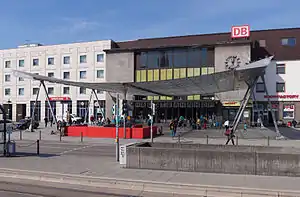 Entrance from east | ||||||||||||||||||||||||||||||||||||||||||||||||||||||||||||||||||||||||||||||||
| Location | Bahnhofplatz 1, Ulm, Baden-Württemberg Germany | |||||||||||||||||||||||||||||||||||||||||||||||||||||||||||||||||||||||||||||||
| Coordinates | 48°24′0″N 9°59′0″E | |||||||||||||||||||||||||||||||||||||||||||||||||||||||||||||||||||||||||||||||
| Owned by | Deutsche Bahn | |||||||||||||||||||||||||||||||||||||||||||||||||||||||||||||||||||||||||||||||
| Operated by | ||||||||||||||||||||||||||||||||||||||||||||||||||||||||||||||||||||||||||||||||
| Line(s) |
| |||||||||||||||||||||||||||||||||||||||||||||||||||||||||||||||||||||||||||||||
| Platforms | 12 | |||||||||||||||||||||||||||||||||||||||||||||||||||||||||||||||||||||||||||||||
| Connections |
| |||||||||||||||||||||||||||||||||||||||||||||||||||||||||||||||||||||||||||||||
| Other information | ||||||||||||||||||||||||||||||||||||||||||||||||||||||||||||||||||||||||||||||||
| Station code | 6323 | |||||||||||||||||||||||||||||||||||||||||||||||||||||||||||||||||||||||||||||||
| DS100 code | TU[1] | |||||||||||||||||||||||||||||||||||||||||||||||||||||||||||||||||||||||||||||||
| IBNR | 8000170 | |||||||||||||||||||||||||||||||||||||||||||||||||||||||||||||||||||||||||||||||
| Category | 2[2] | |||||||||||||||||||||||||||||||||||||||||||||||||||||||||||||||||||||||||||||||
| Fare zone | DING: 10[3] | |||||||||||||||||||||||||||||||||||||||||||||||||||||||||||||||||||||||||||||||
| Website | www.bahnhof.de | |||||||||||||||||||||||||||||||||||||||||||||||||||||||||||||||||||||||||||||||
| History | ||||||||||||||||||||||||||||||||||||||||||||||||||||||||||||||||||||||||||||||||
| Opened | 1 June 1850 | |||||||||||||||||||||||||||||||||||||||||||||||||||||||||||||||||||||||||||||||
| Electrified | 15 May 1933 | |||||||||||||||||||||||||||||||||||||||||||||||||||||||||||||||||||||||||||||||
| Passengers | ||||||||||||||||||||||||||||||||||||||||||||||||||||||||||||||||||||||||||||||||
| 29,000[4] (2005) | ||||||||||||||||||||||||||||||||||||||||||||||||||||||||||||||||||||||||||||||||
| Services | ||||||||||||||||||||||||||||||||||||||||||||||||||||||||||||||||||||||||||||||||
| ||||||||||||||||||||||||||||||||||||||||||||||||||||||||||||||||||||||||||||||||
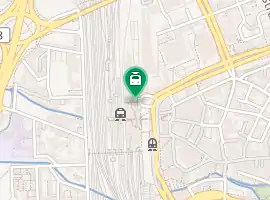
| ||||||||||||||||||||||||||||||||||||||||||||||||||||||||||||||||||||||||||||||||
| Location | ||||||||||||||||||||||||||||||||||||||||||||||||||||||||||||||||||||||||||||||||
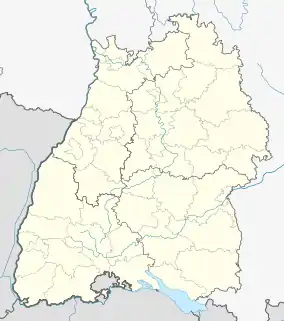 Ulm Location in Baden-Württemberg  Ulm Location in Germany  Ulm Location in Europe | ||||||||||||||||||||||||||||||||||||||||||||||||||||||||||||||||||||||||||||||||
Ulm Hauptbahnhof has twelve platforms, of which five are terminating platforms, and forms a major railway junction. Other stations in the city are Ulm-Söflingen to the west and Ulm Ost (east) to the east and Ulm-Donautal (Danube valley) in the industrial area. The Ulm marshalling yard is located to the west of the city. Neu-Ulm (New Ulm), which lies across the Danube in Bavaria, has the stations of Neu-Ulm, Finningerstraße and Gerlenhofen.
Ulm is located on the railway line from Stuttgart to Munich, over which Intercity-Express trains operate, and part of the Magistrale for Europe (trunk line) from Paris to Budapest. European cities such as Amsterdam, Budapest, Paris and Linz can be reached without transfers. Every day, about 29,000 passengers use the station.[4] It is used daily by about 335 trains operated by Deutsche Bahn and Agilis, 75 long-distance and 260 regional trains. The station is served by local trains that are coordinated by the Donau-Iller-Nahverkehrsverbund (Danube-Iller Local Transport Association, DING).
Location

Ulm Hauptbahnhof is to the west of central Ulm. The station building is located in the east of the tracks on Bahnhofplatz (station square or forecourt). East of the station is Friedrich-Ebert-Strasse, which becomes Olgastraße at the forecourt. Opposite the station building Bahnhofstrasse (station stre et) runs from the forecourt towards Münsterplatz (cathedral aquare), which is about 500 metres away. Schillerstraße runs west of the station. Federal highway 19, which is called Karlstraße at this point, crosses the tracks to the north of the station over Ludwig Erhard Bridge, formerly called the Blaubeurer-Tor (Blaubeuren Gate) bridge. In the south, Neuen Straße runs under the tracks through the Ehinger-Tor (Ehingen Gate) underpass and Zinglerstraße crosses over the tracks on Zingler Bridge. Southeast of the station building is the Ulm central bus station.
Railway lines
The Ulm Hauptbahnhof is the hub of several major railway lines. The Fils Valley Railway, running via Geislingen, Göppingen and Plochingen to Stuttgart, is a double-track and electrified main line, used for domestic and international long-distance traffic at a maximum speed of 160 km/h. Long-distance services also run from Ulm on the electrified and double-track main line via Günzburg to Augsburg, which has a maximum speed of 200 km/h. Both railways are used by InterCity Express, Intercity and EuroCity trains. The Ulm–Friedrichshafen railway, running via Biberach (Riss), Aulendorf and Ravensburg to Friedrichshafen is a double track and non-electrified line. The route is upgraded for 140 km/h and serves mainly regional traffic, although an intercity train pair runs over it each day.
In addition, two lines begin in Ulm: the Ulm–Sigmaringen railway via Ehingen (Donau) to Sigmaringen (continuing as the Tuttlingen–Inzigkofen railway to Tuttlingen and the Black Forest Railway to Donaueschingen) and the Aalen–Ulm railway via Heidenheim to Aalen. These two lines are single track and non-electrified railways that are used by regional services, although the Ulm–Sigmaringen railway has two tracks as far as Herrlingen.
Specifically Ulm is served by the following timetable (KBS) routes:
- KBS 750: Ulm–Geislingen–Göppingen–Plochingen–Stuttgart
- KBS 751: Ulm–Biberach (Riss)–Aulendorf–Ravensburg–Friedrichshafen
- KBS 755: Ulm–Ehingen (Donau)–Sigmaringen–Tuttlingen–Donaueschingen
- KBS 756: Ehingen (Donau)–Ulm–Memmingen
- KBS 757: Ulm–Heidenheim–Aalen
- KBS 975: Ulm–Memmingen–Kempten–Oberstdorf
- KBS 980: Ulm–Gunzburg–Augsburg
- KBS 993: Ulm–Günzburg–Donauwörth–Ingolstadt–Regensburg.
History
As early as 1834, there were plans for a railway between Cannstatt, Ulm and Friedrichshafen. In August 1835, some citizens of Ulm joined formed an initiative to promote its construction. Then on 21 December 1835, the Ulm Railway Company (Ulmer Eisenbahngesellschaft) was founded; it had already spent 80,000 guilders on the day of its incorporation. On 18 April 1843, the construction of the section from Stuttgart through the Swabian Alb (Swabian Jura) range to Ulm was approved rather than the originally planned, longer variantion via Aalen. However, there were arguments about the location of Ulm station. The military architect Moritz Karl Ernst von Prittwitz and the city and cathedral architect Ferdinand Thrän favoured an option for a station to the north of the centre on an east–west alignment. Because this option would have meant that the extension of the line to Friedrichshafen would have run through Bavarian territory, the Württemberg engineers instead planned a railway station aligned north-south at its current location to the west of the city. Although the price of this land was higher and nine roads were disrupted, compared to the disruption of only three roads under the northern option, the north-south option was chosen. Ulm’s western suburbs are now separated from the inner city as a result.
In the race against Bavaria and Baden to complete the first rail connection to Lake Constance, Württemberg began building the Southern Railway to Friedrichshafen via Biberach, with major work beginning in the summer of 1847. The first earthworks and foundation works for Ulm station in August 1848 and work began on the buildings in March 1849. The contracts for the excavation, blasting and construction were awarded by the Royal Württemberg State Railways to small contractors. Because of possible landslides on Kuhberg (hill), just before Ulm station, the Danube was moved and the Southern Railway was built on reclaimed land on the old river bed.[5] The economy of Ulm benefited from the construction, particularly establishments supplying meals for the workforce. The first locomotive trial ran from Biberach to Ulm on 17 May 1850.[6][7]
1850–1866: opening and connecting to other railway lines

Ulm station was officially opened together with the last section of the Southern Railway from Biberach to Ulm on 1 June 1850.[8] On 29 June 1850, the railway up the Geislinger Steige pass over the Swabian Alb between Geislingen and Amstetten was completed, allowing the Württemberg East Railway (Fils Valley Railway), running to Stuttgart via Göppingen, to be taken into operation, so that through trains could run from Heilbronn to Friedrichshafen. Thus, the first railway line across Württemberg was completed. The climb over the Geislinger Steige was a technical masterpiece for the time and attracted attention throughout Europe. Three trains ran each day through the three tracks of the station towards Stuttgart and Friedrichshafen. The travel time between Ulm and Stuttgart was four hours and between Ulm and Friedrichshafen it was three hours and 15 minutes. The station building, which was designed by the architect Ludwig Friedrich Gaab in a style combining gothic revival and neoclassical elements, was opened in December 1850. It consisted of a two-story central building, which had three-storey side towers at each end, and contained on the ground floor an entrance hall, two waiting rooms, a station restaurant, a luggage room, a room for the service staff, a room for the porter and two cash rooms with anterooms. Upstairs there were storage rooms and living areas. Ashlar, brick and crushed stone were used as materials. Two entrance halls to the station building were built in 1851. Also built were a roundhouse, a carriage house, a goods shed, a water station and several other buildings.[8] Railway telegraph was connected to the station on 16 April 1851 and Ulm station opened a porter service on 9 October 1851.
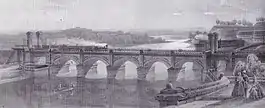
On 25 April 1850, the Kingdom of Bavaria signed a treaty with the Kingdom of Württemberg to extend the railway line between Munich and Augsburg to Ulm and connect with the Württemberg railway network. In March 1852, construction began on the railway bridge over the Danube. The first train arrived at Neu-Ulm station after 25 December 1853; this was officially opened on 26 September together with the Neu-Ulm–Burgau section of the Bavarian Maximilian’s Railway. Since the Danube bridge had not yet been completed, a droshky service operated between Ulm and Neu-Ulm station. The Danube bridge, which from the beginning was designed for two tracks, was completed on 1 May 1854.[8] This consisted of Keuper sandstone and was 123 metres long and 8.55 metres wide. It was called the Wilhelm-Maximilian Bridge in honour of the reigning kings of Württemberg and Bavaria and it had iron gates at both ends. On 1 June, the entire Maximilian’s Railway from Ulm to Augsburg was opened to Munich and Ulm station became a railway junction. Four trains ran daily each way on the new line, with express trains taking three hours 30 minutes and ordinary passenger trains taking five to six hours. The station was a border station and an interchange station between Bavaria and Württemberg with separate station facilities operated by the two kingdoms. The Royal Bavarian State Railways’ operations were in the southern part of the station in its own wing of the station building, which had bay platforms. It became known as the Bayerischer Bahnhof (Bavarian station). Since Bavarian time was ten minutes ahead of Württemberg time, there were two different times used at the station. At the end of 1856, the line between Ulm and Neu-Ulm was duplicated.[9]
In 1855, a separate winter and spring timetable was introduced. On 17 May 1856, the connection through Ulm was opened to international trade, allowing the transportation of wood, grain, tobacco, cement, bricks and coal for the steam engines by rail. Steam engines were being installed because the current of the Blau was no longer sufficient to supply the increasing demand for energy. Ulm doubled its exports between 1852 and 1855. A post office opened in February 1856 and the first hotel (Hôtel de Russie, later renamed Zum Russischen Hof) was opened at the station on 1 May 1857. On 12 October 1862, the Iller Valley Railway was opened from Neu-Ulm to Memmingen with four trains running daily and it was extended to Kempten on 1 June 1863. The same day, the second track of the Fils Valley Railway from Ulm to Stuttgart was taken into operation after four years of construction. Once the Royal Bavarian Railways Office was moved to New Ulm, on 1 January 1861, the operations of the existing Württemberg and Bavaria joint station was transferred completely to Württemberg, with the exception of vehicle and locomotive operations, by 1 December 1863. Part of Bahnhofstraße (station street), which was completed in 1867, was built in January 1865, covering over the Blau. Part of the fortress wall built in the Middle Ages was demolished at the end of 1866 to give the station direct access to the city centre. In 1866, the private entrepreneur Philip Berblinger built the Berblinger building with 36 apartments at the end of Karlstraße as the first building in Ulm for railway workers.[10][11][12]
1867–1891: first and second phase of expansion


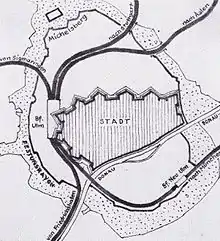
The station building was rebuilt from 1867 until 1880. This added cast iron arches and corner pavilions, so the building was now 75.2 metres long and 13.7 metres wide, and an iron, two-span train shed was established from 1872 to 1874.[8] On 25 March 1867, construction of the line to Blaubeuren began with the demolition of the walls of the Fortress of Ulm at Kienlesberg (hill). The line to Blaubeuren was opened on 2 August 1868. This was followed by the extension to Ehingen in 1869 and to Scheer on the border of the Hohenzollern Province in 1870. Finally the Scheer–Sigmaringen section was opened in 1873. In 1874, following its completion, six trains ran daily from Ulm to Stuttgart, seven trains ran from Stuttgart to Ulm, five pairs of trains ran between Ulm and Friedrichshafen, six pairs of trains ran between Ulm and Augsburg, four pairs of trains between Ulm and Kempten and five pairs of trains ran between Ulm and Blaubeuren. From 1868 to 1871, the depot, which had been located to the west of the platforms was moved to the north into the triangle former between the Danube Valley Railway and Fils Valley Railway.
On 25 June 1875 the first trial run operated over the newly constructed Brenz Railway from Aalen via Heidenheim to Ulm and it was opened on 5 January 1876. An earlier opening was not possible due to the Brenz Railway clause of 21 February 1861, which pledged Württemberg not to build a rail link for twelve years between the Stuttgart-Nördlingen railway (Rems Railway/Ries Railway) and Ulm, otherwise the route from Nördlingen to Lake Constance would have been shorter via Württemberg than via the Ludwig South-North Railway through Bavaria. On 24 January 1877, the footbridge that crossed the station and connected it to the Zum Russischen Hof hotel was completed; its construction had started in July 1875. In August 1877, the Blaubeurer-Tor bridge was opened across the tracks to the north of the station, replacing the existing Karlstraße level crossing. The bridge was an iron truss bridge, 225.6 metres long and ten metres wide. In October 1986, it was demolished and replaced by the Ludwig Erhard bridge opened on 26 October 1989. In 1879, the post office located next to the station, was rebuilt and extended. Ulm Stuttgarter Tor station, north of the inner city, which today is called Ulm Ost (east), opened on the Brenz Railway on 20 September 1886.
The second phase of expansion of the station began in 1888 and continued until 1891, involving the expenditure of 2.6 million German gold marks. The existing eastern storage sidings between Wilhelmstrasse and the Fils Valley Railway to the north-east of Ulm station, which still exist, were opened in 1888. On 26 March 1889, electric light was installed at the station, using electricity from the station’s own steam-powered, power plant on Schillerstraße. The station building was rebuilt again from 1889 to 1890. The cast-iron arches were replaced by a lobby that was 42 metres long and eight metres wide and was used for the ticket office. In 1891, the platform underpass was built, replacing the existing pedestrian level crossings. In the same year, at the end of the second construction phase, Ulm station had 22 tracks, four of which were used for passengers, five for freight and 13 for shunting.[13][14]
1891–1913: planning and construction of the marshalling yard


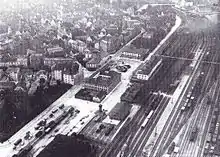
On 1 August 1891, the Ulm general post office established a railway post office in the station forecourt. In March 1892, the duplication of the Maximilians Railway between Augsburg and Neu-Ulm was completed, so that the whole line between Munich and Stuttgart via Ulm was duplicated. On 1 October 1893, platform tickets were introduced for entry to the platforms. On 3 November 1894, the first petrol-powered railcar service ran from Ulm to Blaubeuren; it was powered by a Daimler-Otto engine from Maschinenfabrik Esslingen. On 27 April 1897, an Ordinarischiff (“ordinary boat”, a simple wooden boat, which could convey freight and passengers downstream only and was steered with poles) left Ulm for Vienna down the Danube for the last time, as they could no longer compete against the railway. On 15 May 1897, the Ulm tramway was opened, with the first line running through the station forecourt. In September 1898, a fountain with a crowned Atlas was erected in the forecourt; it was donated by the Schwenk Company, a local cement manufacturer. In one year from 1 April 1898 to 31 March 1899, Ulm station was used by 1,211,199 passengers and was the fourth busiest station in Württemberg. Ulm handled a total of 390,864 tons of freight, which placed it third in Württemberg.[15]
In 1899 and 1900, the city of Ulm considered lowering the station by four metres in order to solve the traffic problems on the connections between the inner city and Western Ulm. This project was supported by several experts, but was not pursued because of its high cost of at least twelve million marks. Instead, a plan was developed in 1901 and 1902 to relocate the passenger station along with the planned marshalling yard to Blaubeurerstraße so that it was aligned east-west and to redevelop the former railway land. The lines to Augsburg and Friedrichshafen would be connected to the new railway station by a tunnel through the Kuhberg and New Ulm would be bypassed. A new South Station would be built on the new line in the Söflingen district near today's Königstraße. This project was also rejected by the administration of the State Railway due to its high cost.
The Münster Hotel was opened in 1901 as another station hotel on the station forecourt opposite the station building. The Mohrenkopf bridge, built in 1903 and 1904 over the southern station tracks, was completed on 1 October 1904; it was later renamed after the governor of the fortress, Rudolf von Zingler, as Zingler bridge. The city and the State Railway had disputed for years whether to build an overpass or an underpass. With the opening of the bridge, the level crossing on Ehinger Straße was closed. From March 1906, the city of Ulm planned an underpass under the tracks between Bahnhofstrasse in the east and Schillerstraße in the west of the station, which was never carried out.
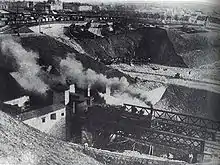
Because the old freight handling facilities could not keep pace with rising freight traffic, a freight yard and marshalling yard situated to the east of Ulm station on the Danube Valley Railway was urgently needed. In 1899, the Royal Württemberg State Railways bought the 67,259 square metres of the fortress lands to use as its yard. On 25 September 1902, Württemberg King Wilhelm II granted the State Railway the right to expropriate the required land, so construction of the marshalling yard could begin in 1903. Operations began on a part of the new rail yard in October 1906. On 28 April 1907, the new Ulm-Söflingen station was opened on the Danube Valley Railway at the western end of the marshalling yard, replacing the previous Söflingen station opened in 1868. The Neutor bridge crossing the Fils Valley and the Brenz Railways to the north of Ulm station was completed in July 1907. It was 112 metres long, 11.6 metres wide and weighed 600 tons. While the iron structures and pillars were built by the State Railways, the roadway was built by the city of Ulm. The first ticket machine was installed in the station vestibule on 7 January 1908. The Bahnhofsmission (a charity that assists with various social problems at German stations) was established in Ulm in the late summer of 1910. The railway yard was completed on 12 June 1911 and Ulm station was renamed Ulm Hauptbahnhof (Ulm main station).[8] Duplication of the Danube Valley Railway from Ulm to Söflingen was completed on 19 March 1912 and duplication of the Southern Railway from Ulm to Friedrichshafen, begun in 1905, was completed in 1913.
Industrial tracks were required to connect the yard to the industrial and commercial areas to the east and west of the city. In 1907, the 3.8 kilometre-long Ulm-West industrial tracks were built and the five main tracks were connected to the premises of 40 companies. The 1.3 kilometre-long Ulm-Ost (east) industrial tracks, which had been proposed in 1897, were built from 1910 to 1911, and stayed in operation until 9 May 1979, when they were closed and later dismantled.[16][17]
1914–1939: World War I and electrification
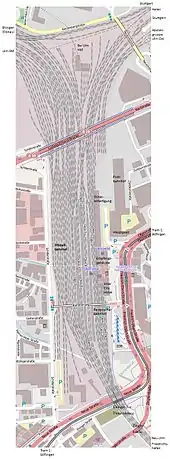
In the First World War from 1914 to 1918, troops, military supplies, prisoners of war and cars were transported through the station. Passenger services on all lines in Württemberg were closed due to lack of coal on 19 October and from 5 to 15 November 1919 for the first time. On 1 April 1920, the Royal Württemberg State Railways and all the other German state railways were absorbed into Deutsche Reichsbahn. In January and February 1922, there were again restrictions on rail traffic due to lack of coal and strikes. In 1923, the station forecourt was redesigned. From July 1930, the D 208 express made the fastest train run in Württemberg, taking 78 minutes over the 104 kilometre route from Ulm to Friedrichshafen.
In September 1931, for the electrification of the railway line from Stuttgart to Augsburg via Ulm, the tracks are lowered below the Zingler, Neutor and Wallgraben bridges as the minimum clearance height had to be increased by 1.2 metres for the installation of the overhead line. In the same month the double-track tunnel on the Fils Valley Railway that had previously passed under the fortress wall had its roof removed. Ulm Ost (east) station was established at one of the old tunnel portals in April 1932. The station footbridge from the station forecourt to Schillerstraße had to be raised in February 1932 by 1.2 metres for the installation of the overhead line. In April 1933, the station building was replastered to prepare for the official inauguration of the electrification. On 25 April 1933, the electrification of the Maximilian’s Railway from Augsburg to Ulm was inaugurated and passenger train 906 hauled by locomotive E 32 31 operated as the first electric train from Augsburg to Ulm. On 5 May 1933, electrification was inaugurated on the Fils Valley Railway from Stuttgart to Ulm with the arrival of the first electric train from Stuttgart. The official inauguration of the electrification of the whole railway line from Stuttgart to Augsburg, however, was only held on 30 May 1933. The Blaubeurer-Tor Bridge to the north of the station, built in 1877, was demolished in June 1932 and replaced with a new steel bridge, which was opened on 13 July 1933. It was the largest bridge in Ulm with a length of 226 metres, a width of 17.7 metres and a weight of 1600 tons.
On 10 November 1933, test runs were conducted on the 86-kilometre Augsburg–Ulm route and on the 71-kilometer section of the Fils Valley Railway from Ulm to Plochingen, the two sections of the line that were completed, each at speeds of up to 152 km/h, in 54 minutes. In January 1935, test runs on the Stuttgart–Ulm railway were carried out with the first new unit AC electric multiple units, which reached 100 km/h instead of the normal 35 km/h on the Geislinger Steige and as a result the Fils Valley Railway was covered in an hour without stopping. In 1937, duplication started on the Söflingen–Herrlingen section of the Danube Valley Railway, which was completed in the 1939.[18] From 1 November 1937 to 31 March 1941, a Deutsche Reichsbahn express bus ran from Stuttgart to Ulm on the new autobahn.[19] On 17 December 1938, the renovation work at the station building, which had been started in the summer, was finished. The third class restaurant was replaced by a 13-metre-wide passage to the platforms and the second class restaurant was rebuilt as a toilet block. On 14 April 1939, under an order issued by the Ministry of Transport in 1936, the Bahnhofsmission was replaced by the station services of the National Socialist Women's League.[20][21]
1939–1949: destruction in the Second World War and reconstruction
After the start of World War II on 1 September 1939, Ulm Jews were “deported” for the first time on 1 December 1941. By February 1945, Deutsche Reichsbahn had transported 116 Ulm Jews to the concentration camps in seven deportations, with most of them being sent to the Theresienstadt concentration camp. Private rail travel became less and less tolerated from 23 March 1942. On 16 March 1944, the first air raid was carried out on Ulm station, inflicting damage in the southern part of the station and killing two railway employees. This was followed by other attacks in the months of July, August and September, but did not lead to the cessation of railway operations. On 17 December 1944, the heaviest air raid on Ulm was carried out with the dropping of 65 explosive and about 3,500 incendiary bombs on the railway. As a result, all the tracks, the station building of 1850 and all the outbuildings were destroyed so that train operations were not possible and all operations had to be moved to the marshalling yard. All passenger operations were restored by 9 January 1945. On 25 February 1945 there was another air raid on the station, which destroyed the Wallstraßen bridge, and eight more followed up to 19 April. On 19 April 1945, the next major air raid took place on the station and marshalling yard, which led to the complete cessation of operations. On 23 April 1945, railway staff left all pars of the station and went to Laupheim. On 24 April 1945, the railway bridge over the Danube between Ulm and Neu-Ulm was blown up during the invasion by the United States Army. All objects that the United States Air Force had previously targeted for destruction had been destroyed.
In May 1945, a temporary wooden bridge was built across the Danube, replacing the demolished railway bridge. That same month, a Christian aid station was established in a temporary shed at the station and it handled a daily average of 3000 travellers until mid-1946. A total of 28,200 people stayed at the shed from April 1949 until the middle of December 1952, when it was demolished.[22] On 16 May 1945, the first military trains ran again for the French and Americans between Friedrichshafen and Ulm and on 8 June 1945, Deutsche Reichsbahn operated on the line from Kornwestheim via Stuttgart and Ulm to Augsburg. From 29 June, electric trains could operate from Ulm to Neu-Ulm, but, on 30 June, civilian travel between the French and the American occupation zones was forbidden, affecting, among other lines, the Southern Railway.[18] On 21 August 1945, 24 passenger trains ran daily via Ulm Hauptbahnhof, most of them serving the occupying authorities and military. On 3 September, civilian freight traffic resumed. On 19 December 1945, private passenger services were briefly discontinued due to a coal shortage so that vital food shipments could continue and, on 1 April 1946 after the resumption of services, fares were increased by 150 percent. On 29 April, the Ulm yard was reopened along with the platform subway at the station. From 1945 to 1959, as a result of its location as the last town before the border between the American and French occupation zones and being a major transportation hub, Ulm was the main place in Southern Germany for storing rolling stock. Between 1945 and 1948, well over 200,000 war veterans and 300,000 refugees from Eastern Europe travelled through Ulm station.[23]
From 18 May 1946, Bahnhofstraße was opened to traffic again after being cleared of debris. In the summer timetable of 1946, Ulm was served by 60 passenger trains a day and, from 16 June 1946, through trains ran over the whole length of the Stuttgart–Ulm railway. Deutsche Reichsbahn built, from October to December 1946, a shed that served as the station restaurant behind the temporary shed that served as the station building in the station forecourt. Here the bricks of the war-damaged Zum Russischen Hof hotel were used as a building material. In 1947, the city of Ulm made plans to move the station, but they failed. It managed, however, to prevent the Reichsbahn’s planned extension of the railway facilities to the east. In March 1947, the Bahnhofhotel-Gaststätte (Station hotel-restaurant), which was housed in a makeshift building, opened as a replacement for the destroyed Bahnhofshotel (Station Hotel). In the same month the Ulm rubble railway (Trümmerbahn), operated with a steam locomotive, was put into service between the inner city and Friedrichsau, hauling 1.2 million cubic metres of rubble to the treatment plants before it was closed on 31 March 1955. In April 1948, the ruins of the general post office were cleared from the station forecourt and a shed for the post office was built up to 12 December 1948 on an unused loading track. On 23 May 1949, the platform footbridge that had been completed in 1877 was demolished. This had been damaged at the end of the war and was difficult, but still passable. Initially it was intended to replace it by extending the platform underpass to Schillerstraße on the west side of the tracks. The plan was abandoned in favour of a new platform footbridge.[24]
1949–1981: new construction and expansion of the reception building
On 7 September 1949, Deutsche Bundesbahn was founded as the successor of Deutsche Reichsbahn in the territory of the Federal Republic of Germany. In October 1949, the wooden beams of the temporary bridge over the Danube River built in 1945 were replaced with steel beams. On 7 November 1950, the new Bundesbahn Hotel (called Bubaho by the people of the city) with 130 rooms was opened after a construction period of 18 months. In 1950, Ulm Hauptbahnhof sold 1.16 million tickets. On 6 April 1951, a radio system for controlling shunting was commissioned in Ulm station. On 21 March 1952, a Railroad Transportation Office was established for U.S. soldiers. In December 1952, the temporary sheds on the station were demolished so that construction of the new station building could begin. On 19 December 1953, Deutsche Bundesbahn employees moved into the new station building. In 1955, the freight processing and loading facilities were rebuilt. On 16 May 1955, the new general post office was completed in the station forecourt; its construction had begun on 6 October 1952 and it would be opened on 9 July 1955. Construction of the station pedestrian bridge, which had begun in 1954, was completed on the 5 August 1955. After the Hungarian Revolution was put down, the station handled trains carrying Hungarian refugees for several weeks from 30 November 1956. The construction of the railway bridge over the Danube, which had begun on 24 November 1955, was opened on 31 October 1957. The bridge over the Danube handled 160 trains per day at this time and was one of the busiest bridges in southern Germany.
The Bahnhofhotel-Gaststätte hotel, built in 1947, was demolished in April 1959 so that it could be replaced by the Bundesbahnhotel. On 28 July 1960, the Ulm city council decided to build a road tunnel to the south of Ulm station (the Ehinger-Tor underpass) and the Zingler bridge a little further to the south. Ulm postal station opened on 13 October 1962 for the loading and unloading of the post. The final stage of the entrance building began on 11 January 1964[8] with the extension of the north wing, which was to last two years. However, the construction work stopped in April due to financial and structural problems. After lying to the south of the station, Ulm Central Bus Station was taken into operation provisionally on 22 December 1961; it would be finally completed in September 1964. Because of its high traffic density Ulm station was classified on 1 July 1966 as belonging to the highest level of Deutsche Bundesbahn’s station categories, category 1. The interior of the entrance building was renovated in December 1966. Construction of Neuen Straße (new street), including the Ehinger-Tor underpass, to the south of the station was completed on 22 September 1966; its construction had started in November 1964. The Ulm tramway that used to run over the Zingler bridge was transferred to run through the underpass, with services starting on 29 May 1967.[25]
In January 1968, the old Zingler bridge to the south of the station was demolished for the construction of the new Zingler bridge, opened on 5 December 1968. Extension work on the north wing of the station building, which had been abandoned in 1964, was resumed in September 1969, but, it was stopped again due to financial problems on 7 May 1971. In June 1970, unused sheds were demolished for facilities to handle baggage. On 26 August 1969, construction began on a pedestrian underpass under the station forecourt, for which the channel of the Kleine Blau (Little Blau) under the station had to be moved. In October 1970, the remains of fortifications from the 14th and 16th century were discovered. On 21 December 1970 the underpass, which connects the station with the city centre and the tram and bus station, was opened.
Work began on 18 August 1971 to enlarge the station building to increase the number of beds in the Bundesbahn hotel for the 1972 Summer Olympics held in Munich. This was completed on 7 July 1972. In September 1971, the construction work on the northern part of the entrance building resumed again following complaints by the railway workers' union and the north wing was completed in February 1973.[8] The platform barriers were abolished on 1 May 1973. On 16 May 1976, at 11:15, the last steam-hauled passenger train left the station for Sigmaringen. In February 1978, platforms 1 to 3 were raised from 38 centimetres to 76 centimetres, platform 3 was extended to 320 metres and a fourth platform was built, requiring the platform underpass to be extended.[8]
Deutsche Bundesbahn modernised the Fils Valley Railway between Stuttgart and Ulm up to 12 October 1981, introducing reversible working of the tracks.[26]
Since 1982: planning of high-speed lines and modernisation
In July 1985, Deutsche Bundesbahn began planning a high-speed line from Stuttgart to Munich. A new line was planned from Süßen to Günzburg to bypass Ulm to the north; it would have connected with the existing line in Beimerstetten. These plans, however, met with strong opposition from the residents of Ulm and Neu-Ulm, as the transfer of the main station and the freight yard to the new line to the north of Ulm in the suburb of Jungingen was proposed. On 15 October 1990, Deutsche Bundesbahn said, however, that the realisation of the Ulm bypass was unlikely and, on 7 September 1993, it finally decided not to implement the Ulm bypass. In October 1991, a further variant of the high-speed line between Stuttgart and Ulm was proposed. Besides the previous version, which was now called the K route, and that line with the Ulm bypass omitted, there was the H route, which was a new line for long-distance traffic from Stuttgart Hauptbahnhof via the Swabian Alb to Ulm Hauptbahnhof, running parallel to the A 8 autobahn; the Fils Valley Railway would continue to serve regional and freight traffic. On 8 December 1992, the Deutsche Bundesbahn board approved the selection of the H route.

From May 1986, Deutsche Bundesbahn planned to relocate the central bus station underground and redevelop the space vacated with an office complex. On 21 January 1992, the city of Ulm approved these plans. On 25 September 1986, a baggage conveyor belt on the stairs of the platform tunnels was placed in operation. For the commencement of Intercity-Express services in 1991, the old Bundesbahn Hotel (which since 1982 had been called the InterCity Hotel) was demolished in April 1991 and a new InterCity Hotel was built by 1992 and opened on 1 September 1992. A passenger information system with a computer-controlled display of rail services was put into operation in the station on 22 October 1992. A trial of the new tilting Pendolino (class 610) trains ran between Stuttgart and Ulm on 11 December 1993. The station forecourt was redesigned and a glass roof was built over the main entrance by 4 December 1993.
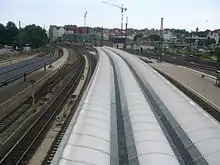
On 1 January 1994, Deutsche Bahn AG was established as the successor of the Deutsche Bundesbahn and the East German railways (Deutsche Reichsbahn). On 29 November 1994, Deutsche Bahn opened a new travel centre at Ulm station and, on 8 April 1995, Ulm station became the first station in Baden-Württemberg to have tactile paving to guide the blind. From 28 May, some regional trains ran between Stuttgart and Ulm with double-deck coaches. In August 1995, the bicycle parking facilities at the station were covered. On 31 December 1997 the handling of freight was closed and the platforms for postal operated closed on 23 January 1998. Class 610 tilting trains took over scheduled operations of regional services on the Danube Valley Railway between Ulm and Sigmaringen from 24 May 1998. Construction work, including installation of a new glass roof, began on platform B with platform tracks 2 and 3 in March 2000 and it was completed in August 1998.[27]
In 2005, the Ulm container terminal (Ulm Umschlagbahnhof or Ulm Ubf) was opened on the Fils Valley Railway on the northern border of the city of Ulm at Dornstadt with four 700 metre-long tracks, where up to 100,000 TEUs can be handled each year, making it one of the eleven yards serving unit trains in hub and spoke operations in Germany. The old station footbridge was demolished in 2008 and replaced by a new structure, which was completed in summer 2011.
Structure
Station building

Located to the east of the tracks is a four-storey entrance building, which is divided into the Intercity Hotel in the south, the central part with the entrance hall and the north wing.
In December 1952, after the Second World War, work began on erecting makeshift huts on the station destroyed in the war so that construction of the permanent station building could commence. Deutsche Bundesbahn opened the new station building on 19 December 1953 after twelve months of construction. Many citizens of Ulm were unhappy with the station building and the simultaneous restructuring of the station area; Carl Ebner, the first chairman of the Tourist Office of Ulm/Neu-Ulm, called it "the biggest train wreck of Ulm".[28] On 11 January 1964, the final stage of building the station began with the extension of the north wing, which was to last two years. However, the construction work ended in April due to financial and structural problems. In September 1969, the development work was resumed on the north wing, but it was stopped again on 7 May 1971 due to further financial problems. On 18 August 1971, the upgrade of the station building began in order to increase the number of beds of the Deutsche Bundesbahn Hotel for the 1972 Summer Olympics held in Munich. This was completed on 7 July 1972. In September 1971, the construction on the northern part of the entrance building resumed because of complaints from the railway workers' union and in February 1973, the north wing was completed with offices and a canteen.[29] From 22 October 1973 to 5 December 1974, the station building was rebuilt in order to move the baggage storage and handling into the main hall.[8] In May 1978, Deutsche Bundesbahn opened a tourist office in the entrance building and on 22 October 1992,[30] it put a computerised departure board with a split-flap display into operation in the station. Deutsche Bahn opened the concourse on 29 November 1994 and a new travel centre on 20 March 1996 equipped with a “Service Point”, using new technology.[31]
In the lobby of the building there is a large two-piece LCD departures board and the stairs to the platform underpass. To the south of the entrance hall the Markt im Bahnhof (market in the station) was opened on 1 September 1992 with a variety of shops.[32] The main entrance to the lobby is almost entirely glazed and the area outside the main entrance in the station forecourt was covered by a glass roof extending into the road on 4 September 1993.[33] Under the glass roof are the stairs to the underpass that connects the station with the tram and bus station and the city centre. Directly adjoining to the entrance to the north wing there are more shops, the travel centre and a connection to the former freight shed. The InterCity Hotel with 135 rooms opened on 1 September 1992 as a replacement for the old Deutsche Bundesbahn Hotel, which was demolished in April 1991 and stood on the same site.[32]
Platforms and platform tracks

The station has seven platform tracks on four platforms and five bay platforms, with track 1 next to the station building. Two bay platforms, 5a in the north and 5b in the south, are on the middle platform, which is bordered by tracks 4 and 6. Bay platforms 25, 26, 27, 28, and 29 were originally part of the Bayerischer Bahnhof (Bavaria station), located to the south of the entrance building and west of the bus station, and are used by regional trains to Bavaria. Tracks 26 and 29 have no platform and serve as sidings. Between tracks 1 and 2 is track 21, which has no platform and is used as a through track for freight trains and as a siding. Deutsche Bahn divides some platform tracks into “north” and “south” sections, so that two trains can stop at the same time on the track. All platforms are covered and have digital destination displays. The central platforms are connected by an underpass to the station building. Further north there is an underpass that connects the main platform with the central platforms, which is accessible for the disabled with ramps. This does not continue to the platform facing tracks 7 and 8, so they do not have barrier free access. There are no lifts.
| Platforms | Length in m[34] | Height in cm[34] | Use |
|---|---|---|---|
| 1 | 499 | 76 | Long-distance towards Stuttgart, Regionalbahn services to Geislingen |
| 2 | 408 | 76 | Long-distance towards Munich |
| 3 | 446 | 76 | Intercity train pair: Münster–Innsbruck, Regional services towards Stuttgart, Friedrichshafen and Biberach |
| 4 | 322 | 76 | Intercity train pair: Hannover–Oberstdorf, Regionalbahn services towards Biberach Platform 4 north: Regional services towards Stuttgart and Ehingen Platform 4 south: Regional services towards Memmingen |
| 5a | 107 | 76 | Regional services towards Aalen and Ehingen |
| 5b | 109 | 76 | Regionalbahn services towards Memmingen |
| 6 | 461 | 76 | Regionalbahn services towards Langenau Platform 6 north: Regional services towards Ehingen and Aalen Platform 6 south: Regional services towards Friedrichshafen and Biberach |
| 7 | 359 | 76 | Regional services towards Ehingen, Langenau and Memmingen |
| 8 | 335 | 76 | Regional services towards Ehingen, Biberach, Friedrichshafen and Illertissen |
| 25 | 236 | 76 | Regional services towards Munich |
| 27 | 186 | 38 | Regional services towards Ingolstadt and Munich |
| 28 | 158 | 38 | Regional services towards Ingolstadt |
Rail operations
History of rail services
Ulm Hauptbahnhof has always been an important hub for long-distance and regional services. At its opening in 1850, three pairs of trains per day ran from Ulm to Stuttgart and to Friedrichshafen. The travel time between Ulm and Stuttgart was four hours and between Ulm and Friedrichshafen it was three hours and 15 minutes.[35] After the first opening of the Bavarian Maximilian Railway in June 1854, four pairs of trains also ran between Ulm and Munich, with express trains taking three hours 30 minutes and stopping trains taking five to six hours.[36] In the summer timetable of 1860, Ulm was first served by a scheduled night train and in 1865 a night train ran from Vienna to Paris, stopping at Ulm station. From 1862, four pairs of trains operated on the newly opened Iller Valley Railway between Ulm and Kempten.[37] On 15 May 1867, an express service was established on the Paris–Ulm–Vienna route, which took 19 hours and ten minutes from Ulm to Paris and 16 hours and 35 minutes from Ulm to Vienna.[38] In 1874, six trains ran daily from Ulm to Stuttgart, seven trains ran from Stuttgart to Ulm, five train pairs ran between Ulm and Friedrichshafen, six pairs of trains ran between Ulm and Augsburg, four pairs of trains ran between Ulm and Kempten and five pairs of trains ran between Ulm and Blaubeuren.[39] On 5 June 1883, the first Orient Express from Paris to Constantinople stopped in Ulm at 11:35 after leaving Paris Gare de l'Est at 19:36 on the previous day. The train operated on Wednesdays and Saturdays to Ulm and had a running time of 78 hours from Paris to Varna. The connection from Varna to Constantinople was by ship.[40] At the beginning of World War I, the operation of the Orient Express was closed. As a replacement, the Balkan Express was established from Strasbourg to Constantinople on 15 January 1916, but this was shortened in June 1917, due to weak demand, to the Munich–Constantinople route and thus no longer served Ulm. From July 1930, the D 208 corridor express ran as the fastest Württemberg train on the 104 kilometre Ulm-Friedrichshafen route in 78 minutes.[41]
During World War II, train traffic was severely restricted, and after some air raids stopped running altogether. Services resumed after the end of World War II and 24 passenger trains stopped at Ulm station on 21 August 1945.[42] On 28 May 1967, the station became part of the Trans-Europ-Express network, which had been established in 1957 and only had first class accommodation. From 28 May 1967, the TEE Rembrandt from Amsterdam to Munich and the Rheinpfeil from Dortmund to Munich, with coaches from Amsterdam, stopped at Ulm.[43] On 26 September 1971, Intercity services were introduced, stopping every two hours at the station. Until 1979, Ulm was served by first class only services on line 1 of the intercity network, running between Hamburg-Altona and Munich, although, unlike most other cities served by Intercity trains, it had less than 100,000 inhabitants.[44] The Rheinpfeil lost its TEE status and was integrated into Intercity line 1. With the summer timetable introduced on 27 May 1979, Intercity trains ran every hour and now had first and second class carriages.[45] On 28 May 1983, the TEE Rembrandt service was shortened to Stuttgart, meaning that it no longer stopped at Ulm. In December 1985, a portion of the TEE Rheingold that had run from Amsterdam to Munich and Salzburg via Aalen and Donauwörth since May 1982 was rerouted via Ulm, but on 30 May 1987, it was abolished. On 2 June 1991, Deutsche Bundesbahn introduced the Intercity-Express into traffic, with the hourly Intercity route from Hamburg-Altona via Hannover, Frankfurt and Stuttgart to Munich replaced by the new ICE trains. In a controversial move, it was decided to stop the ICE in Ulm.[32]
Passenger services to Laupheim town, branching off the Southern Railway at Laupheim West on the Laupheim–Schwendi railway, which were closed in 1983, resumed on 30 May 1999 as an hourly Regionalbahn service from Langenau via Ulm to Laupheim town or Biberach (Riss), with regional shuttles using class 650 diesel railcars.[46] Interregio-Express (IRE) line 26 from Saarbrücken via Mannheim, Stuttgart, Ulm and Friedrichshafen to Lindau, running every two hours, opened in 1990, was reinstated on 15 December 2002 and an additional IRE service, also running every two hours, ran on the Stuttgart–Ulm–Lindau section of the route. Later, the IRE network was further expanded.
Long distance services
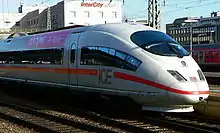
In 2012, Ulm Hauptbahnhof is served at least hourly by Intercity-Express, Intercity and Euro City trains. The two ICE routes, 11 and 42, run every two hours, so together an hourly service is provided. Route 11 is operated with ICE 1 sets with seven pairs of trains running between Berlin Ostbahnhof and Munich and one between Hamburg-Altona and Munich. Route 42 is served with ICE 3 trains and connects the Ruhr region with Munich via Frankfurt. It is operated with six pairs of trains from Dortmund to Munich, one from Münster and Hamm to Munich, which is coupled to another set in Dortmund and a pair of trains from Hamburg-Altona to Munich. TGV route 83 runs with a pair of trains daily between Munich and Paris using TGV POS sets. In addition, twice a week, a railjet train pair runs on route 90 between Frankfurt and Wiesbaden and Budapest.
Intercity route 60 and EuroCity route 62 each run every two hours so that together an hourly service is also produced. Gaps in the schedule are filled by individual services on routes 32. Intercity route 60 runs with five pairs of trains between Karlsruhe and Munich, one between Strasbourg and Munich and another between Karlsruhe and Salzburg. Two pairs of trains run on Euro City route 62 from Frankfurt to Klagenfurt, one pair of trains from Frankfurt to Graz, another from Frankfurt to Linz, one from Frankfurt to Munich and a pair of trains from Saarbrücken to Graz. One pair of trains on route 32 is coupled on part of its journey with a EuroCity route 62 service and runs under the name of Wörthersee between Münster and Dortmund and Klagenfurt. The second pair of trains on route 32 runs as an Intercity between Münster and Innsbruck and turns on to the Southern Railway in Ulm. The third Intercity route 32 train pair runs between Dortmund and Oberstdorf under the name of the Allgäu and between Stuttgart and Ulm forms part of the route 60 two-hourly pattern. It turns in Ulm on to the Iller Valley Railway and runs from Ulm to Oberstdorf as a Regional-Express, while it runs on the return journey along its entire length as an Intercity. The trains running on route 32 between Münster and Innsbruck and between Hannover and Oberstdorf are the only long-distance trains that branch off the Stuttgart–Munich main line in Ulm.
The following long-distance services operate through Ulm Hauptbahnhof:
| Line | Route | Frequency | |||
|---|---|---|---|---|---|
| ICE 11 | Hamburg-Altona – Berlin Hbf – Leipzig – Erfurt – Fulda – Frankfurt Hbf – Mannheim – Stuttgart – Ulm – Augsburg – Munich | Every 2 hours | |||
| ICE 11 | Wiesbaden – Mainz – Mannheim – Stuttgart – Ulm – Munich | Individual services | |||
| ICE 42 | (Hamburg-Altona – Hamburg Hbf – Bremen – Münster –) Dortmund – Essen – Duisburg – Düsseldorf – Cologne – Frankfurt Airport – Mannheim – Stuttgart – Ulm – Augsburg – Munich | Every 2 hours | |||
| TGV 83 | München – Augsburg – Ulm – Stuttgart – Karlsruhe – Strasbourg – Paris Est | One train pair | |||
| RJ 90 | Budapest – Wien Westbf – Salzburg – Munich – Augsburg – Ulm – Stuttgart – Mannheim – Frankfurt Airport – Frankfurt Hbf (– Wiesbaden) | One train pair twice weekly | |||
| EC/IC 32 | Münster/Dortmund – Essen – Duisburg – Düsseldorf – Cologne – Bonn – Koblenz – Mainz – Mannheim – Heidelberg – Stuttgart – Ulm – | Augsburg – Munich – Salzburg – Klagenfurt | One train pair | ||
| Friedrichshafen – Lindau – Innsbruck | One train pair | ||||
| Memmingen – Kempten – Oberstdorf | One train pair | ||||
| IC 60 | (Strasbourg –) Karlsruhe – Stuttgart – Ulm – Augsburg – Munich (– Salzburg) | Every 2 hours | |||
| EC 62 | Frankfurt Hbf – Heidelberg – | Stuttgart – Ulm – Augsburg – Munich – Salzburg (– Klagenfurt / Graz / Linz) | Four train pairs | ||
| Saarbrücken – Mannheim – | |||||
Regional services
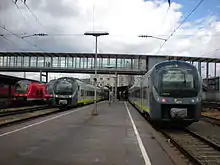
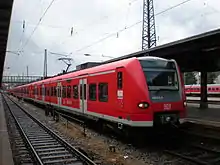
In 2012, Ulm Hauptbahnhof is served in regional transport by Interregio-Express, Regional-Express and Regionalbahn services operated by DB Regio and by services operated by private operators. Ulm is a hub in Baden-Württemberg's Inter-Regional Express network. Its IRE trains from Stuttgart and Ulm operate to Lindau (Südbahn) and from Ulm to Basel (IRE-Sprinter) on the Ulm–Friedrichshafen railway, from Ulm to Aalen on the Aalen–Ulm railway and from Ulm to Neustadt (Black Forest) on the Ulm–Sigmaringen railway, Tuttlingen–Inzigkofen railway, Black Forest Railway and Höllentalbahn (most of this route is known as the Danube Valley Railway or Donautalbahn). With the exception of the connection to Lindau, which is operated hourly, each service runs every two hours. Services are operated with electric locomotives of class 146 or diesel locomotives of class 218, hauling double-deck coaches and class 611 diesel multiple units.
Regional-Express trains run on all routes running through Ulm, except on the Southern Railway, while all routes through Ulm are served by Regionalbahn services (local trains). In addition to locomotive-hauled push-pull trains with double-deck or Silberling carriages, there are Regio-Shuttles of class 650 and class 612 diesel multiple units and class 425 and 440 (Coradia Continental) electric multiple units. Trains of the private railway company Agilis have run since 11 December 2011 on the Ulm–Augsburg railway as far as Günzburg, continuing via the Ingolstadt–Neuoffingen railway to Ingolstadt and the Regensburg–Ingolstadt railway to Regensburg, which also use Coradia Continental EMUs.
Until October 2013, at the weekend the historical railbus, the UlmerSpatz, also ran from Ulm on the Danube Valley Railway and the Reutlingen–Schelklingen railway through the Swabian Jura (KBS 759). This has now been replaced by newer (though still vintage) DMUs operated by the SAB.
The following regional services operate through Ulm Hauptbahnhof:
| Connection | Route | Frequency |
|---|---|---|
| IRE | Südbahn: Stuttgart – Plochingen – Ulm – Aulendorf – Ravensburg – Friedrichshafen – Lindau |
every 2 hours |
| IRE | Südbahn: Ulm – Aulendorf – Ravensburg – Friedrichshafen – Lindau |
every 2 hours |
| IRE | IRE-Sprinter: Ulm – Ravensburg – Friedrichshafen – Singen (Hohentwiel) – Schaffhausen (CH) – Basel Bad Bf |
every 2 hours |
| IRE | Aalen – Heidenheim – Giengen (Brenz) – Langenau (Württ.) – Ulm | every 2 hours |
| IRE | Donautalbahn: Ulm – Sigmaringen – Tuttlingen – Donaueschingen – Neustadt (Schwarzwald) |
every 2 hours |
| IRE | Ulm – Sigmaringen – Tuttlingen – Donaueschingen – Triberg | single trains |
| RE | Mosbach-Neckarelz – Heilbronn – Stuttgart – Göppingen – Ulm | every hour |
| RE 57 | Ulm – Heidenheim – Aalen | every hour |
| RE | Ulm – Schelklingen – Ehingen – Sigmaringen | every 2 hour |
| RE | Ulm – Memmingen – Kempten (Allgäu) (– Immenstadt – Röthenbach / Oberstdorf) | every hour |
| RE | Fugger-Express: Munich – Augsburg – Günzburg – Neu-Ulm – Ulm |
every hour |
| RB | (Stuttgart – Plochingen – Göppingen –) Geislingen (Steige) – Ulm | every hour |
| RB 56 | Ulm – Schelklingen – Munderkingen | every hour |
| RB 57 | Ulm – Thalfingen (b Ulm) – Langenau (Württ) | every hour |
| RB | Ulm – Laupheim Stadt – Biberach (Riß) | every hour |
| RB | Ulm – Laupheim West – Biberach (Riß) – Aulendorf | single trains |
| RB | Ehingen – Schelklingen – Ulm – Neu-Ulm (– Illertissen) | every hour |
| RB | Ulmer Spatz: Ulm – Schelklingen – Münsingen – Kleinengstingen |
1 train on Sunday |
| RB | Ulm – Neu-Ulm – Illertissen – Memmingen (– Kißlegg – Aulendorf) | every 2 hours |
| RB | Ulm – Neu-Ulm – Illertissen – Memmingen (– Kempten (Allgäu) (– Oberstdorf)) | every 2 hours |
| RB | Ulm – Neu-Ulm – Günzburg – Dinkelscherben (– Augsburg) | single trains |
| RB | Ulm – Neu-Ulm – Günzburg – Krumbach (Schwaben) (– Mindelheim) | single trains |
| ag | Ulm – Neu-Ulm – Günzburg – Donauwörth – Ingolstadt – Regensburg (– Eggmühl – Landshut) | every 2 hours |
| ag | Ulm – Neu-Ulm – Günzburg – Donauwörth – Ingolstadt | every 2 hours |
Local traffic


There is a stop in the station forecourt served by Ulm tramline 1 (Ulm’s only tramline) and bus lines 3, 5, 6, 7, 8 and 10 of Stadtwerke Ulm/Neu-Ulm (a company providing municipal services in Ulm and Neu-Ulm).
The Ulm tramway opened two lines to the Ulm station forecourt on 15 May 1897. While one tram line linked the stations of Ulm and Neu-Ulm, the other ran on the ring around the city centre. Construction of the Zingler Bridge that crosses the tracks south of the station gave the residents of the suburbs lying to the west of the station a connection to the Ulm trams that they had long demanded. The tram crossed the bridge and continued to Söflingen from 18 October 1906. On 14 May 1947, an Ulm trolleybus service was put into operation; its two lines had a stop at Ulm station. It replaced tramline 2 to Neu-Ulm, which had been closed on the 24 December 1944 due to the effects of the war. On 23 October 1963, the trolleybus operation was abandoned and replaced by diesel buses. Starting from 22 May 1967, Ulm tramline 1 used the Ehinger-Tor underpass, completed in 1966, from Donaustadion to Söflingen instead of the Zingler bridge. On 21 March 2009, line 1 was extended from Donauhalle to Böfingen.[47]
| Connection | Route |
|---|---|
| 1 | Söflingen – Westplatz – Ehinger Tor – Hauptbahnhof – Willy-Brandt-Platz – Donaustadion – Donauhalle – Böfingen Süd – Böfingen |
| 3 | Wiblingen Alte Siedlung – Reutlinger Straße – Pranger – Donaubad – Ehinger Tor – Hauptbahnhof – Kienlesberg – Eselsberg Hasenkopf – Universität Süd – Wissenschaftsstadt (– Science Park II) |
| 5 | Wissenschaftsstadt – Heilmeyersteige – Kienlesberg – Hauptbahnhof – Rathaus Ulm – Neu-Ulm ZUP – Ludwigsfeld / Wiley |
| 6 | (Universität Süd –) Eselsberg Hasenkopf – Bahnhof Söflingen – Kienlesberg – Hauptbahnhof – Rathaus Ulm – Donaustadion |
| 7 | Jungingen – Michelsberg – Hauptbahnhof – Ehinger Tor – Neu-Ulm ZUP – Willy-Brandt-Platz |
| 8 | Wiblingen Pranger – Alte Siedlung – Reutlinger Straße – Donautal – Grimmelfingen – Kuhberg – Ehinger Tor – Hauptbahnhof – Blautal-Center |
| 10 | Hauptbahnhof – Ehinger Tor – Donautal |
Future
Stuttgart–Augsburg new and upgraded line
A new line from Stuttgart to Augsburg (Stuttgart–Augsburg new and upgraded railway) is planned. This project, to be completed by 2020, includes the Stuttgart 21 project and a new high-speed line from Stuttgart to Ulm (called the Wendlingen–Ulm high-speed railway). In the long term, the line from Ulm to Augsburg will be extensively upgraded for a top speed of 200 km/h. The Danube bridge was upgraded to four tracks and the Neu-Ulm station was rebuilt in a trench during the Neu-Ulm 21 project.
As a result of the Stuttgart–Augsburg new and upgraded railway project, long-distance and regional traffic to Ulm is expected to increase. In the next few years, the entire station area, the surrounding streets and neighbourhoods are to be completely redesigned and rebuilt in a project known as Citybahnhof Ulm. Basically, the station building is to be rebuilt into a modern city station along with underground connections to the city, to a yet to be built shopping centre and to the Dichterviertel, which is situated on the other side of the railway tracks.
The remodelling of the Ulm station is part of zone 2.5a1 of the Wendlingen–Ulm project. The application for planning approval was made on 23 December 2005. On 7 May 2007, the Federal Railway Authority asked the Government of the Tübingen region to carry out the consultation process. The public hearing was held on 22 June 2009. The consultation report, which took into account various changes to the plan that had already been made, was completed on 18 December 2009.[48]
In early June 2010, Deutsche Bahn issued a Europe-wide tender for the construction supervision of this section. Accordingly, this provided in the station area for the adaption or the construction of 8.52 km of track, for the construction of 150 and the reconstruction of 83 sets of points, the development of the southern end of the station to six tracks, the construction of a double track (585 m long) and a single track (150m long) concrete-lined trenches, two railway bridges and 1,000 m of noise barriers. A total of 74 stages of construction are envisaged. The contract runs from October 2010 to December 2019.[49] In mid-July 2012, clearance of the construction site began.[50]
On 18 January 2012, the Federal Railway Authority asked the Tübingen region to conduct an additional consultation process on further changes to the plans. These changes include the elimination of the originally planned fifth platform in the station, the elimination of Ulm Ost station and modifications to soundproofing and waste water technology. Deutsche Bahn justified the omission of the fifth platform with operational improvements as a result of the concentration of all train parking in a new vehicle maintenance facility and sidings. The Ministry of Transport and Infrastructure doubted whether the platform could actually be eliminated if long-term service improvements (including the planned Danube-Iller Regional S-Bahn) are to be implemented.[48] A critic sees the S-Bahn concept compromised if the fifth platform is not provided from the outset. If a fifth platform is actually necessary, according to the DB, funding would have to be provided for separately. The DB is not aware of formal plans for an S-Bahn.[48][51]
Deutsche Bahn puts the cost of connecting the new line to the station, including further work, at about €120 million. These costs are borne by the federal government, Deutsche Bahn and the state of Baden-Württemberg. Deutsche Bahn expects the planning decision to be made at the end of 2012 and construction to start in 2013 (as of March 2012).[48]
Danube-Iller Regional S-Bahn
The Donau-Iller-Nahverkehrsverbund (Danube-Iller Local Transport Association, DING) is planning the introduction of an urban rail network designated as the Danube-Iller Regional S-Bahn (Regio-S-Bahn Ulm/Neu-Ulm) or Ulm/Neu-Ulm S-Bahn. Its central node would be Ulm station. The first line from Ulm station to Weißenhorn would go into operation at the timetable change in December 2013. The Senden–Weißenhorn railway, closed for passenger traffic in 1966 and only currently used for freight, would be reactivated for passengers. More services would be provided on the Southern Railway to Ummendorf, the Danube Valley Railway to Blaubeuren and Obermarchtal, the Fils Valley Railway to Geislingen, the Brenz Railway to Langenau and Aalen on the Neu-Ulm–Kempten railway and the Leutkirch–Memmingen railway to Buxheim and Tannheim and the Mittelschwaben railway to Mindelheim.
Notes
- Eisenbahnatlas Deutschland (German railway atlas) (2009/2010 ed.). Schweers + Wall. 2009. ISBN 978-3-89494-139-0.
- "Stationspreisliste 2021" [Station price list 2021] (PDF) (in German). DB Station&Service. 16 November 2020. Retrieved 3 December 2020.
- "Der Wabenplan" (PDF). Donau-Iller-Nahverkehrsverbund. 1 January 2020. Retrieved 19 March 2020.
- "Answer to parliamentary question on stations in Baden-Württembergs" (PDF) (in German). Parliament of Baden-Württemberg. 16 February 2005. Archived from the original (PDF) on 17 October 2013. Retrieved 7 December 2012.
- David Hruza (2012). Verkehrsknoten Ulm (Donau) (in German). Freiburg: EK-Verlag. pp. 19–22. ISBN 978-3-88255-245-4.
- Hans Kuhn (1983). Ulmer Eisenbahngeschichte 1835 bis 1945 (in German). Langenau/Ulm: Armin Vaas Verlag. pp. 14–32. ISBN 3-88360-039-3.
- Stefan J. Dietrich (2000). Ulm und die Eisenbahn (in German). Stadtarchiv Ulm. pp. 5–11. ISBN 3-87707-549-5.
- Burkhard Thiel. "Etwas zur Geschichte des Bahnhofs" (in German). Ziel Bahnhof. Retrieved 9 December 2012.
- Wolfgang Stoffels (2000). Das Bw Ulm. 150 Jahre Betriebswerkstätten, Schienenfahrzeuge und Technische Anlagen (in German). Freiburg: Ek-Verlag. p. 17. ISBN 3-88255-449-5.
- Hans Kuhn (1983). Ulmer Eisenbahngeschichte 1835 bis 1945 (in German). Langenau/Ulm: Armin Vaas Verlag. pp. 25–38. ISBN 3-88360-039-3.
- Stefan J. Dietrich (2000). Ulm und die Eisenbahn (in German). Stadtarchiv Ulm. pp. 11–19. ISBN 3-87707-549-5.
- David Hruza (2012). Verkehrsknoten Ulm (Donau) (in German). Freiburg: EK-Verlag. pp. 22–23. ISBN 978-3-88255-245-4.
- Hans Kuhn (1983). Ulmer Eisenbahngeschichte 1835 bis 1945 (in German). Langenau/Ulm: Armin Vaas Verlag. pp. 40–53. ISBN 3-88360-039-3.
- Stefan J. Dietrich (2000). Ulm und die Eisenbahn (in German). Stadtarchiv Ulm. pp. 19–26. ISBN 3-87707-549-5.
- Stefan J. Dietrich (2000). Ulm und die Eisenbahn (in German). Stadtarchiv Ulm. p. 28. ISBN 3-87707-549-5.
- Hans Kuhn (1983). Ulmer Eisenbahngeschichte 1835 bis 1945 (in German). Langenau/Ulm: Armin Vaas Verlag. pp. 54–81. ISBN 3-88360-039-3.
- Stefan J. Dietrich (2000). Ulm und die Eisenbahn (in German). Stadtarchiv Ulm. pp. 26–34. ISBN 3-87707-549-5.
- David Hruza (2012). Verkehrsknoten Ulm (Donau) (in German). Freiburg: EK-Verlag. pp. 26–30. ISBN 978-3-88255-245-4.
- David Hruza (2012). Verkehrsknoten Ulm (Donau) (in German). Freiburg: EK-Verlag. p. 13. ISBN 978-3-88255-245-4.
- Hans Kuhn (1983). Ulmer Eisenbahngeschichte 1835 bis 1945 (in German). Langenau/Ulm: Armin Vaas Verlag. pp. 83–93. ISBN 3-88360-039-3.
- Stefan J. Dietrich (2000). Ulm und die Eisenbahn (in German). Stadtarchiv Ulm. pp. 34–42. ISBN 3-87707-549-5.
- Hans Kuhn (1983). Ulmer Eisenbahngeschichte 1835 bis 1945 (in German). Langenau/Ulm: Armin Vaas Verlag. pp. 95–108. ISBN 3-88360-039-3.
- Stefan J. Dietrich (2000). Ulm und die Eisenbahn. German: Stadtarchiv Ulm. p. 48. ISBN 3-87707-549-5.
- Stefan J. Dietrich (2000). Ulm und die Eisenbahn. German: Stadtarchiv Ulm. pp. 42–51. ISBN 3-87707-549-5.
- Stefan J. Dietrich (2000). Ulm und die Eisenbahn (in German). Stadtarchiv Ulm. pp. 51–56. ISBN 3-87707-549-5.
- Stefan J. Dietrich (2000). Ulm und die Eisenbahn (in German). Stadtarchiv Ulm. pp. 57–62. ISBN 3-87707-549-5.
- Stefan J. Dietrich (2000). Ulm und die Eisenbahn (in German). Stadtarchiv Ulm. pp. 62–67. ISBN 3-87707-549-5.
- Stefan J. Dietrich (2000). Ulm und die Eisenbahn (in German). Stadtarchiv Ulm. pp. 53–54. ISBN 3-87707-549-5.
- Stefan J. Dietrich (2000). Ulm und die Eisenbahn (in German). Stadtarchiv Ulm. pp. 56–59. ISBN 3-87707-549-5.
- Stefan J. Dietrich (2000). Ulm und die Eisenbahn (in German). Stadtarchiv Ulm. p. 60. ISBN 3-87707-549-5.
- Stefan J. Dietrich (2000). Ulm und die Eisenbahn (in German). Stadtarchiv Ulm. pp. 64–66. ISBN 3-87707-549-5.
- Stefan J. Dietrich (2000). Ulm und die Eisenbahn (in German). Stadtarchiv Ulm. p. 64. ISBN 3-87707-549-5.
- Stefan J. Dietrich (2000). Ulm und die Eisenbahn (in German). Stadtarchiv Ulm. p. 65. ISBN 3-87707-549-5.
- "Platform information on Ulm station" (in German). Deutsche Bahn. Retrieved 15 December 2012.
- Stefan J. Dietrich (2000). Ulm und die Eisenbahn (in German). Stadtarchiv Ulm. p. 11. ISBN 3-87707-549-5.
- Stefan J. Dietrich (2000). Ulm und die Eisenbahn (in German). Stadtarchiv Ulm. p. 15. ISBN 3-87707-549-5.
- Stefan J. Dietrich (2000). Ulm und die Eisenbahn (in German). Stadtarchiv Ulm. pp. 16–17. ISBN 3-87707-549-5.
- Stefan J. Dietrich (2000). Ulm und die Eisenbahn (in German). Stadtarchiv Ulm. p. 20. ISBN 3-87707-549-5.
- Stefan J. Dietrich (2000). Ulm und die Eisenbahn (in German). Stadtarchiv Ulm. p. 21. ISBN 3-87707-549-5.
- Stefan J. Dietrich (2000). Ulm und die Eisenbahn (in German). Stadtarchiv Ulm. p. 24. ISBN 3-87707-549-5.
- Stefan J. Dietrich (2000). Ulm und die Eisenbahn (in German). Stadtarchiv Ulm. p. 37. ISBN 3-87707-549-5.
- Stefan J. Dietrich (2000). Ulm und die Eisenbahn (in German). Stadtarchiv Ulm. p. 46. ISBN 3-87707-549-5.
- Stefan J. Dietrich (2000). Ulm und die Eisenbahn (in German). Stadtarchiv Ulm. p. 57. ISBN 3-87707-549-5.
- Stefan J. Dietrich (2000). Ulm und die Eisenbahn (in German). Stadtarchiv Ulm. p. 59. ISBN 3-87707-549-5.
- Stefan J. Dietrich (2000). Ulm und die Eisenbahn (in German). Stadtarchiv Ulm. p. 62. ISBN 3-87707-549-5.
- Stefan J. Dietrich (2000). Ulm und die Eisenbahn (in German). Stadtarchiv Ulm. p. 67. ISBN 3-87707-549-5.
- Daniel Riechers (1997). 100 Jahre Straßenbahn Ulm/Neu-Ulm (in German). Ulm: Süddeutsche Verlagsges. ISBN 978-3-88294-239-2.
- "Planfeststellungsverfahren der Schienenneubaustrecke Wendlingen–Ulm 2.5" (PDF). Parliamentary records 15/1365 (in German). State of Baden-Württemberg. 6 March 2012. Archived from the original (PDF, 44 kB) on 20 August 2014. Retrieved 25 December 2012.
- "D-Stuttgart: Baustellenüberwachung (Document 161576-2010)". Tenders in Electronic Daily (in German). European Union. 3 June 2010. Retrieved 25 December 2012.
- "Bahn startet Baufeldfreimachung im Ulmer Hauptbahnhof" (Press release) (in German). Deutsche Bahn. 20 July 2012. Archived from the original on 21 January 2013. Retrieved 25 December 2012.
- Hans-Uli Thierer (13 August 2012). "DB weiß nichts von S-Bahn". Südwestpresse (in German). p. 9 B. Retrieved 25 December 2012.
References
- Stefan J. Dietrich (2000). Ulm und die Eisenbahn (in German). Stadtarchiv Ulm. ISBN 3-87707-549-5.
- Hans Kuhn (1983). Ulmer Eisenbahngeschichte 1835 bis 1945 (in German). Langenau-Ulm: Armin Vaas Verlag. ISBN 3-88360-039-3.
- David Hruza (2012). Verkehrsknoten Ulm (Donau) (in German). Freiburg: EK-Verlag. ISBN 978-3-88255-245-4.
- Albert Mühl, Kurt Seidel (1980). Die Württembergischen Staatseisenbahnen (in German). Stuttgart-Aalen: Theiss. ISBN 3-8062-0249-4.
- Andreas M. Räntzsch (1996). Württembergische Eisenbahn-Geschichte Bd. 1: 1830–1854. Planungsphase und Realisierung der Bauvorhaben (in German). Schweinfurt: H&L Publikationen. ISBN 3-928786-36-9.
- Hans-Wolfgang Scharf (1997). Die Eisenbahn im Donautal und im nördlichen Oberschwaben (in German). Freiburg: EK-Verlag. ISBN 3-88255-765-6.
- Wolfgang Stoffels (2000). Das Bw Ulm. 150 Jahre Betriebswerkstätten, Schienenfahrzeuge und Technische Anlagen (in German). Freiburg: EK-Verlag. ISBN 3-88255-449-5.
External links
| Wikimedia Commons has media related to Ulm Hauptbahnhof. |
- "Track plan of Ulm Hbf" (PDF; 304,2 KB) (in German). Deutsche Bahn. Retrieved 29 December 2012.
- "Citybahnhof Ulm (planned station reconstruction)" (in German). City of Ulm. Retrieved 29 December 2012.
- "Neubaustrecke Wendlingen-Ulm, PFA 2.5a1 Ulm Hauptbahnhof, Planänderung (high-speed line planning documents)" (in German). Tübingen (region). Retrieved 29 December 2012.

